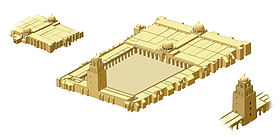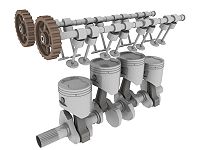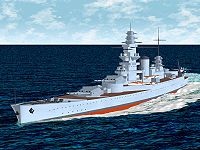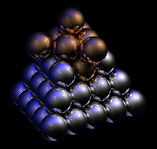- 3D computer graphics
-
This article is about the process of creating 3D computer graphics. For information on the study of computer graphics, see Computer graphics.
3D computer graphics 
Basics 3D modeling / 3D scanning 3D rendering / 3D printing 3D computer graphics software Primary Uses 3D models / Computer-aided design Graphic design / Video games Visual effects / Visualization Virtual engineering / Virtual reality Related concepts CGI / Animation / 3D display Wireframe model / Texture mapping Computer animation / Motion capture Skeletal animation / Crowd simulation Global illumination / Volume rendering 3D computer graphics (in contrast to 2D computer graphics) are graphics that use a three-dimensional representation of geometric data (often Cartesian) that is stored in the computer for the purposes of performing calculations and rendering 2D images. Such images may be stored for viewing later or displayed in real-time.
Despite these differences, 3D computer graphics rely on many of the same algorithms as 2D computer vector graphics in the wire-frame model and 2D computer raster graphics in the final rendered display. In computer graphics software, the distinction between 2D and 3D is occasionally blurred; 2D applications may use 3D techniques to achieve effects such as lighting, and 3D may use 2D rendering techniques.
3D computer graphics are often referred to as 3D models. Apart from the rendered graphic, the model is contained within the graphical data file. However, there are differences. A 3D model is the mathematical representation of any three-dimensional object. A model is not technically a graphic until it is displayed. Due to 3D printing, 3D models are not confined to virtual space. A model can be displayed visually as a two-dimensional image through a process called 3D rendering, or used in non-graphical computer simulations and calculations.
Contents
History
William Fetter was credited with coining the term computer graphics in 1961[1][2] to describe his work at Boeing. One of the first displays of computer animation was Futureworld (1976), which included an animation of a human face and hand—produced by Ed Catmull and Fred Parke at the University of Utah.
Overview
The process of creating 3D computer graphics can be sequentially divided into three basic phases: 3D modeling which describes the process of forming the shape of an object, layout and animation which describes the motion and placement of objects within a scene, and 3D rendering which produces an image of an object.
Modeling
Main article: 3D modelingThe model describes the process of forming the shape of an object. The two most common sources of 3D models are those originated on the computer by an artist or engineer using some kind of 3D modeling tool, and those scanned into a computer from real-world objects. Models can also be produced procedurally or via physical simulation. Basically a 3D model is formed from points generally called „vertex“ which are defining the shape and forming „polygons“. A “polygon” is an area formed from at least three vertexes and in this case the polygon takes the name „triangle“. When the polygon is formed from four points „vertex“ it’s called „quad“ and if from more than four it’s called „n-gon“. The overall integrity of the model and ability to use in animation is depending on the structure of the polygons where the optional polygon is „quad“.
Layout and animation
Main article: Computer animationBefore objects are rendered, they must be placed (laid out) within a scene. This is what defines the spatial relationships between objects in a scene including location and size. Animation refers to the temporal description of an object, i.e., how it moves and deforms over time. Popular methods include keyframing, inverse kinematics, and motion capture, though many of these techniques are used in conjunction with each other. As with modeling, physical simulation is another way of specifying motion.
Rendering
Main article: 3D renderingRendering converts a model into an image either by simulating light transport to get photorealistic images, or by applying some kind of style as in non-photorealistic rendering. The two basic operations in realistic rendering are transport (how much light gets from one place to another) and scattering (how surfaces interact with light). This step is usually performed using 3D computer graphics software or a 3D graphics API. The process of altering the scene into a suitable form for rendering also involves 3D projection which allows a three-dimensional image to be viewed in two dimensions.
Examples of 3D rendering
Left: A 3D rendering with ray tracing and ambient occlusion using Blender and YafaRay.Center: A 3d model of a Dunkerque class battleship rendered with flat shading.
Right: During the 3D rendering step, the number of reflections “light rays” can take, as well as various other attributes, can be tailored to achieve a desired visual effect. Rendered with Cobalt.
Communities
There are a multitude of websites designed to help educate and support 3D graphic artists. Some are managed by software developers and content providers, but there are standalone sites as well. These communities allow for members to seek advice, post tutorials, provide product reviews or post examples of their own work.
Distinction from photorealistic 2D graphics
Not all computer graphics that appear 3D are based on a wireframe model. 2D computer graphics with 3D photorealistic effects are often achieved without wireframe modeling and are sometimes indistinguishable in the final form. Some graphic art software includes filters that can be applied to 2D vector graphics or 2D raster graphics on transparent layers. Visual artists may also copy or visualize 3D effects and manually render photorealistic effects without the use of filters. See also still life.[citation needed]
See also
- 2D computer graphics
- 2.5D
- 3D computer graphics software
- 3D motion controller
- 3D projection on 2D planes
- Anaglyph image
- Computer vision
- Digital geometry
- Geometry pipeline
- Geometry processing
- Graphics
- Graphics processing unit (GPU)
- Graphical output devices
- Image processing
- Isometric graphics in video games
- List of stereoscopic video games
- Medical animation
- Reflection (computer graphics)
- Rendering (computer graphics)
- SIGGRAPH
- Stereoscopy
- Timeline of CGI in films
- Computer-animated television series
References
External links
- A Critical History of Computer Graphics and Animation
- How Stuff Works - 3D Graphics
- History of Computer Graphics series of articles
- 3D Graphics Programming Examples in C++
- 3D Computer Graphic Studio
- 3D-Sphere
Animation topics By country China · India · Japan · Korea · Philippines · United States
Azerbaijan · Canada · China · France · Iran · Japan · Russia · United Kingdom · United States
Industry Animator (List of animators) · Animation director · Animation studios · biologist simulateurs · Animation film festivals (international / regional)
Works Feature-length films · Short films · Television series (1900s) (2000s) · Films based on animated cartoons · Computer-animated films · Stop-motion films
Techniques Clay (strata-cut) · Cutout (silhouette) · Graphic · Model (go motion) · Object · Pixilation · Puppetoon
Flash · PowerPoint · SVG
3DOther methodsDrawn-on-film · Flip book · Inbetweening · Paint-on-glass · Pinscreen · Pixel art · Pose to pose · Sand
Related topics Cartoon series · Cartoon physics · Animated cartoon · Character animation · Independent animation · Adult animation · List of animated shorts available on DVD
Categories:
Wikimedia Foundation. 2010.




